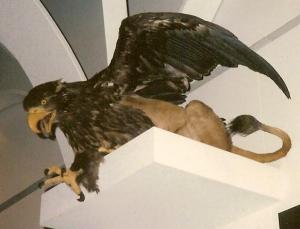Following on yesterday’s post on science in fantasy novels, I thought I’d share some of my musings on griffins. Next year, my daughter will start at a new school the mascot of which is the griffin. So even though I don’t have an immediate plans to put some of these creatures in a story, I do have a bit of a vested interest in wondering about them! Anyway, here is one way to envision griffins working in something like a scientifically plausible setting. I am quite certain there are others!
Griffins appear to be a hybrid of bird and mammal. In fact, they are neither. Rather, they are descendants of therapod dinosaurs. They thus share a common ancestor with birds. While birds quickly learned to fly, however, the ancestors of griffins first became quadrupedal hunters for millions of years before finally taking to the skies. These proto-griffins filled the same ecological niche that the great cats did in more recent times. Their closest fantastic relatives are the hieracosphinx or hawk-headed lion of Egypt and the alce or wingless griffin of Central Asia.
The prehistoric ancestors of griffins were sufficiently bird-like to share several avian adaptations. Even the felid-like portions of their bodies maintain the strong, stiff (but lightweight) bone structure associated with birds. Their muscles are lighter than those of a true cat. Overall, modern griffins and their fantastic cousins weigh only between one-fourth and one-half of what a similar-sized felid would weigh.
A griffin’s feathers graduate from true avian feathers on the head, shoulders, and forelimbs, to downy feathers or protofeathers on the hindquarters that give aerodynamic contour to the body while at the same time making it appear more bulky than it actually is. From a distance, these feathers are easily interpreted as fur. In many species, this graduation ends with a scaly serpentine tail.
In other ways, griffins share a physiology and anatomy similar to both avians and therapods. For example:
- They have three digits on each fore foot and four on each hind foot.
- They have a distinctive carpal bone in the wrist (the semilunate).
- They have a wishbone.
- They lay ornithoid eggs and incubate them in a nest.
- They have a unique and highly efficient bird-like respiratory system.
- Their ribcage is braced by uncinate processes.
Griffins and related species all possess beaks resembling those of ceratopsians. Their young often retain teeth for the first year or so of life. Like birds, they vocalize through an organ in the throat called the syrinx. They are capable of various chirps, hoots, and shrieks similar to those of eagles and other large birds.
Due to a bizarre and unprecedented mutation, a population of winged, hexapodal true griffins developed some time in the early Cenozoic. These creatures possess enormous wings sprouting from their shoulders. In fact, a griffin’s wings and flight muscles make up nearly half of its total body weight. Griffins molt their flight feathers once per year, usually in late summer to early fall, but some evidence of molting can be seen at almost any time of year.
Griffins are soarers like eagles or vultures, relying on thermals and orographic updrafts to sustain their flight. Their strong wing muscles are capable of short bursts of (energetically costly) speed, and their relatively low aspect ratio makes them surprisingly maneuverable flyers for their size.
The archetypal griffin species is the Asian or Scythian griffin (Gryphus asiaticus). This creature is found in the Altai and Tian Shan Mountains of central Asia. It is easily recognized by its swept-back, pointed ears tufts (like a horned owl) and its long, tapering snake-like tail that may be as long as its entire body.
The largest of the griffins, G. asiaticus is comparable in size to a large lion but weighing only about 200 pounds. A large male has a wingspan of up to 25–26 feet. As might be expected, the creature has a voracious appetite. It must consume at least one-tenth of its body weight every day in order to power its flight. These creatures can consume up to one-third of their body weight at a single sitting, storing part of the meal in their crop so they don’t have to hunt every day. Depending on the population density of prey animals, the home range of a northern griffin can extend from 50 to over 300 square miles, roughly 18–20 times that of an eagle.
Asian griffins prey on deer, elk, wild goats, wild boar, and other fauna, but they have a particular fondness for horse meat. For this reason, they are apt to target foals in the spring and summer months. A 120 to 150-pound foal can easily be snatched on the wing by an adult male griffin and will provide enough meat for the male and his mate to eat for several days. A 550-pound yearling will feed a griffin hunting pair for over a week. (Like both lions and eagles, griffins will eat carrion if it is available.)
Although it doesn’t have the strength or body mass of a lion, a griffin can take down prey animals larger than itself by diving upon them at high speed like a falcon and quickly tearing into them with beak and talons. (Note that the Haast’s eagle of New Zealand hunted moas that weighed 15 times more than it did.)
Griffin feathers are tawny like a lion’s fur, but lighter—even white—on the underside of its body and wings. The feathers of the neck are variegated white, tawny, and blue.
Like all griffins, the northern griffin mates for life and rarely seeks a new mate if its first mate dies. The female lays her eggs, usually a clutch of three, in a nest she builds in a cave. These eggs are about the size of ostrich eggs but resemble striated agates.

